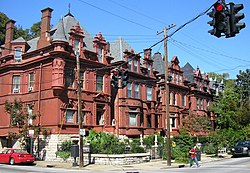Old Louisville
|
Old Louisville Residential District
|
|

Werne's Row at the corner of 4th and Hill
|
|
| Location | Louisville, Kentucky |
|---|---|
| Built | 1850-1920s |
| Architectural style | Late Victorian |
| NRHP Reference # | 84001583 |
| Added to NRHP | July 12, 1984 |
Old Louisville is a historic district and neighborhood in central Louisville, Kentucky, USA. It is the third largest such district in the United States, and the largest preservation district featuring almost entirely Victorian architecture. It is also unique in that a majority of its structures are made of brick, and the neighborhood contains the highest concentration of residential homes with stained glass windows in the U.S. Many of the buildings are in the Victorian-era styles of Romanesque, Queen Anne, Italianate, among others; and a large number of blocks have had few or no buildings razed. There are also several 20th-century buildings from 15 to 20 stories.
Old Louisville consists of about 48 city blocks and is located north of the University of Louisville's main campus and south of Broadway and Downtown Louisville, in the central portion of the modern city. The neighborhood hosts the renowned St. James Court Art Show on the first weekend in October.
Despite its name, Old Louisville was actually built as a suburb of Louisville starting in the 1870s, nearly a century after Louisville was founded. It was initially called the Southern Extension, and the name Old Louisville did not come until the 1960s. Old Louisville was initially home to some of Louisville's wealthiest residents, but saw a decline in the early and mid-20th century. Following revitalization efforts and gentrification, Old Louisville is currently home to a diverse population with a high concentration of students and young professionals.
Old Louisville is not actually the oldest part of Louisville. In fact, large-scale development south of Broadway did not begin until the 1870s, nearly a century after what is now Downtown Louisville was first settled. The area was initially part of three different military land grants issued in 1773, and throughout the early and mid-19th century the land passed through the hands of several speculators, meanwhile much of it was used as farmland. Some of the land south of Broadway was still in its natural state during this time, such as the 50-acre (200,000 m2) tract between Broadway and Breckenridge, known as Jacob's Woods, a popular picnic ground as late as 1845. A major attraction was Oakland Race Track, near today's Seventh and Ormsby, built in 1839 and an early forerunner to Churchill Downs.
...
Wikipedia


